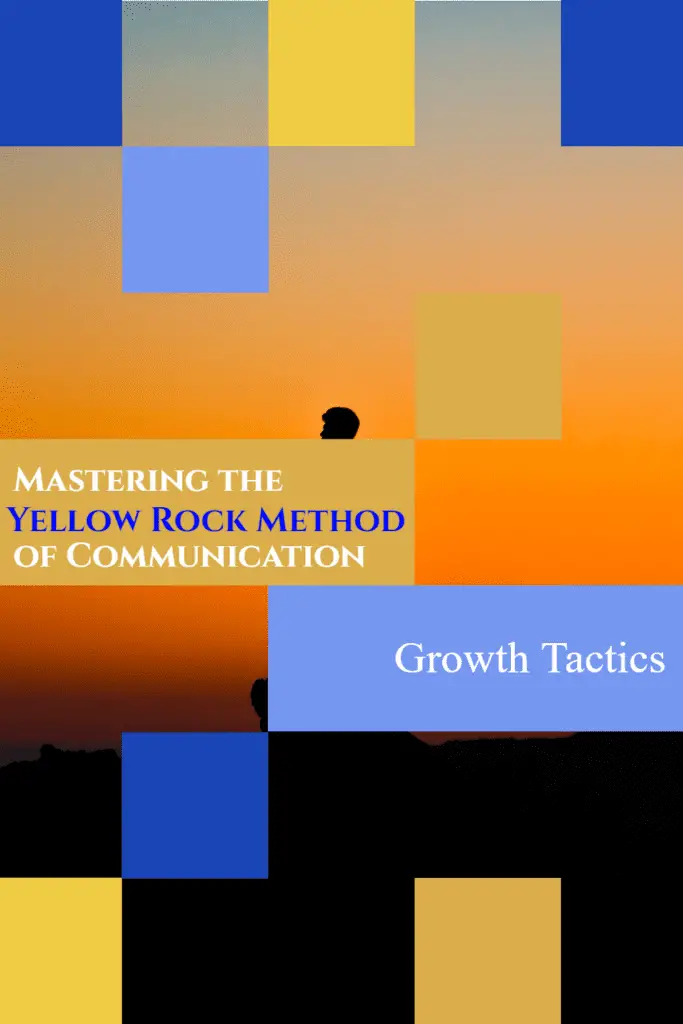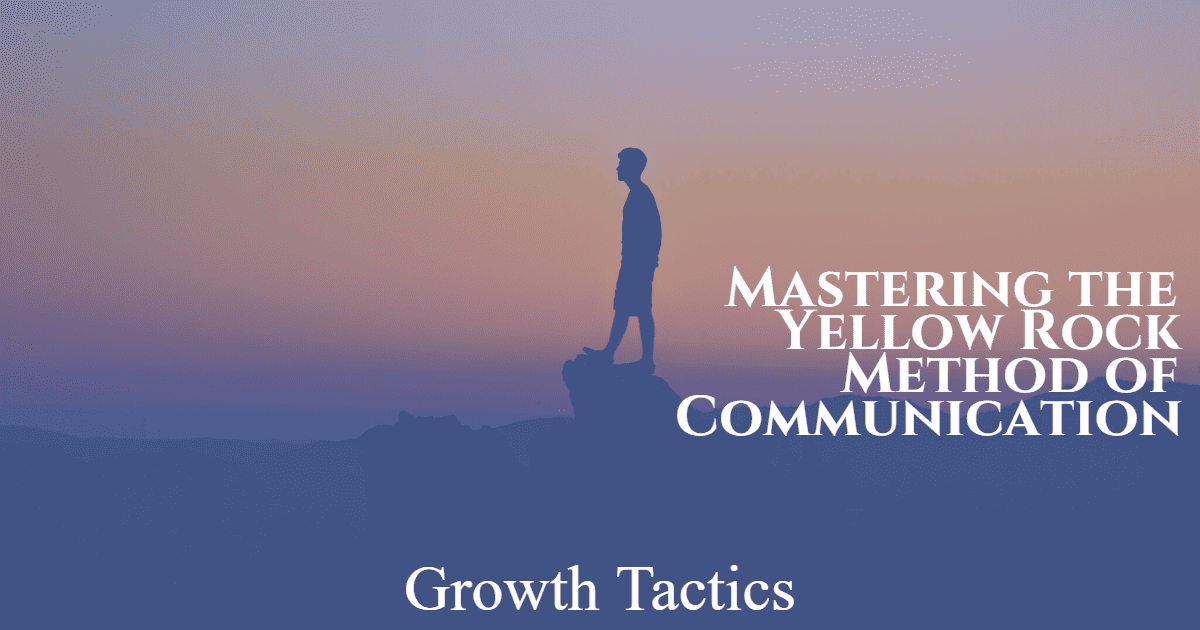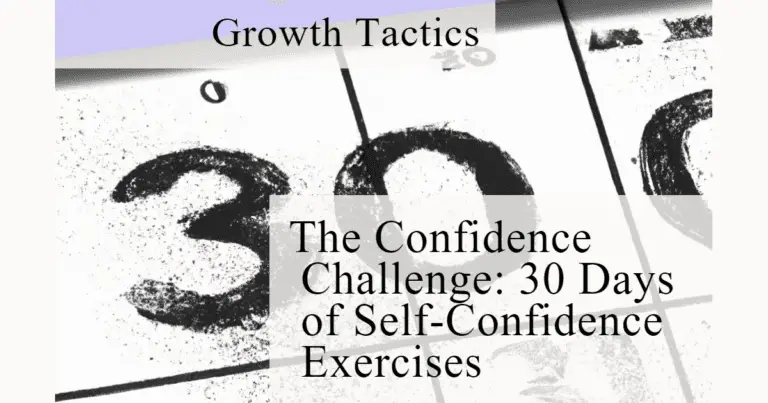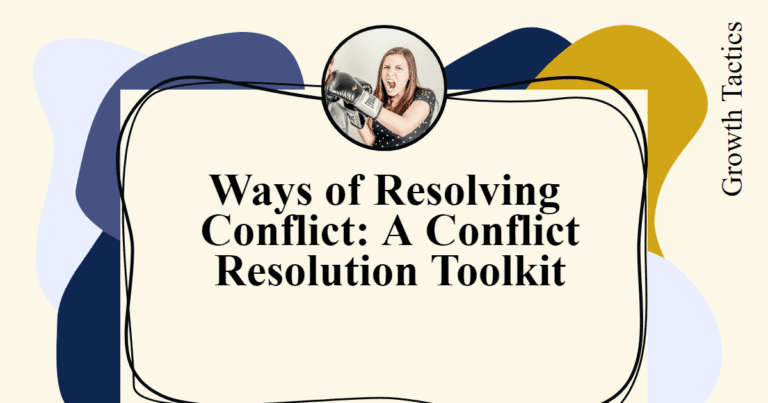In this article, we will explore the Yellow Rock Method of communication and its effectiveness in dealing with high-conflict individuals, specifically narcissists.
We will also touch on the Gray Rock or Grey Rock technique, which complements the Yellow Rock Method.
By understanding and practicing these communication strategies, you can navigate difficult conversations, set boundaries, and protect your emotional well-being.
Jump To Section
What is the Yellow Rock Method?

The Yellow Rock Method, also known as yellow rocking, is a powerful communication technique designed to manage interactions with narcissistic individuals. These high-conflict individuals thrive on attention and seek to control conversations and situations. By employing this technique, you can regain control, establish healthier boundaries, and protect your emotional state.
The Psychology Behind Yellow Rock Responses
Narcissistic individuals often thrive on emotional reactions. Utilizing them as leverage to maintain control.
By adopting the Yellow Rock approach, you effectively disrupt this cycle. The method creates a psychological barrier that inhibits the narcissist’s capacity to provoke or elicit strong responses.
When you maintain a calm demeanor, you not only protect your emotional state but also alter the dynamics of the interaction. This psychological shift enables you to assert dominance in the conversation, as it forces the narcissist to grapple with an unresponsive counterpart.
Furthermore, this technique bolsters self-esteem and confidence, empowering you to engage in future interactions with a greater sense of control and stability. The Yellow Rock responses are a strategic means of reclaiming emotional stability when facing high-conflict individuals, allowing for healthier and more balanced communication.
How Does the Yellow Rock Method Work Against a Narcissist?
1. Stay Unfazed and Calm
Maintaining a sense of calm is essential when interacting with narcissists. The “yellow rock” symbolizes your composed demeanor, acting as a shield against their attempts to provoke you.
By remaining unfazed, you neutralize their power and prevent them from achieving their desired reaction.
When a narcissist tries to engage in a high-conflict conversation or provoke you, it is crucial to stay calm and composed. By refusing to engage in their tactics, you effectively neutralize their power.
Like a yellow rock, you become a symbol of steadfastness and stability, preventing them from manipulating your emotions and gaining control over the conversation. Responding calmly not only sets boundaries but also protects your emotional well-being.
2. Use Strategic Questions
Another key aspect of the Yellow Rock Communication Method involves redirecting the conversation through the use of strategic questions.
Skilled communicators gently steer the discussion towards neutral topics or areas where the narcissist cannot manipulate or exploit your emotions. The goal is to subtly alter the course of the conversation while maintaining control.
By asking open-ended questions, you encourage the narcissist to provide more detailed answers or explanations.
This approach effectively shifts the focus away from their manipulative tactics and redirects it toward a topic that is less likely to cause conflict. Strategic questions can help you regain control of the conversation and prevent the narcissist from monopolizing it for their own gain.
Remember to remain calm and composed while posing these questions. This will allow you to maintain the upper hand and prevent the narcissist from derailing the conversation or manipulating your emotions.
By staying unfazed and using strategic questions, you can effectively employ the Yellow Rock Method to navigate high-conflict conversations with narcissists. These techniques not only protect your emotional well-being but also establish healthier boundaries and regain control over the interaction.
Deploying the Grey Rock Technique
In addition to the Yellow Rock Method, the Grey Rock or Grey Rock technique can be particularly effective when dealing with high-conflict individuals.
The Grey Rock approach involves becoming as uninteresting and unresponsive as a grey rock, ultimately discouraging the narcissist from further engagement.
This technique relies on limiting personal information and maintaining a neutral emotional tone, creating healthy boundaries, and reducing their interest in fueling conflict.
1. Limit Personal Information
To deploy the Grey Rock Technique, it is crucial to limit the amount of personal information you share with the high-conflict individual. Narcissists thrive on gathering personal details and using them as ammunition to manipulate or control others.
By limiting the information you provide, you deprive them of the fuel they need to continue the conflict.
Avoid discussing personal achievements, dreams, or vulnerabilities. Instead, focus on more neutral topics that do not provide them with ammunition or leverage over you.
By withholding personal information, you ensure that the conversation remains superficial and uninteresting to the narcissist.
2. Maintain a Neutral Emotional Tone
Another key aspect of the Grey Rock Technique is to maintain a neutral emotional tone when interacting with the narcissist.
Emotional responses, whether positive or negative, provide them with validation and satisfaction.
By remaining emotionally detached, you decrease their interest in engaging with you and reduce their ability to manipulate your emotions.
Practicing active listening without displaying overt emotional reactions can help you maintain a neutral tone. Respond with neutral phrases such as “I see” or “Interesting,” without showing any significant emotional investment. This can discourage the narcissist from continuing to provoke or engage with you, as they realize their attempts are ineffective.
By limiting personal information and maintaining a neutral emotional tone, you can effectively employ the Grey Rock Technique to create boundaries and discourage further engagement from high-conflict individuals.
This technique allows you to protect your emotional well-being and reduce the narcissist’s interest in fueling conflict.
The Power of Effective Communication
Mastering the Yellow Rock Method and incorporating the Grey Rock technique grants you a valuable skillset in navigating challenging conversations. Beyond just the words spoken, effective communication involves understanding how to control the conversation’s flow and maintain emotional well-being.
By practicing these methods, you can regain control, protect yourself, and navigate high-conflict situations with greater success.
1. Establishing Boundaries
Effective communication starts with establishing clear boundaries. High-conflict individuals often push boundaries and manipulate conversations to suit their needs.
By setting firm boundaries and clearly communicating your expectations, you mitigate the narcissist’s ability to disrupt or control the conversation.
Clearly state your limits and boundaries at the beginning of the conversation and reinforce them throughout.
This can include guidelines on acceptable topics, respectful communication, and expectations for mutual understanding. By asserting your boundaries, you assert your control over the conversation.
2. Active Listening and Empathy
Active listening and empathy play essential roles in effective communication. While high-conflict individuals may not exhibit empathy towards you, it is crucial to demonstrate it yourself.
Show that you are genuinely interested in understanding their perspective, even if you may disagree or find it difficult to empathize.
By actively listening and acknowledging their feelings, you maintain a level of respect and prevent the conversation from escalating into a full-blown conflict. Reflect back on what they say, ask clarifying questions, and validate their emotions.
This demonstrates that you are engaged in the conversation while still maintaining your own emotional well-being.
3. Redirect or Disengage
In some cases, redirecting or disengaging from the conversation may be necessary for your well-being. If the conversation becomes too confrontational or the narcissist becomes increasingly manipulative, it is essential to prioritize your own emotional health.
Redirect the conversation by introducing a new topic or gently steering it away from contentious areas.
If redirecting doesn’t work or the conversation becomes too overwhelming, disengaging may be the best option. This can involve politely ending the conversation or excusing yourself from the situation.
Remember that effective communication also includes knowing when to walk away or limit further engagement. Your well-being should always be a priority in high-conflict situations.
By establishing boundaries, practicing active listening and empathy, and knowing when to redirect or disengage, you harness the power of effective communication.
These skills not only allow you to navigate challenging conversations with high-conflict individuals but also help you maintain your emotional well-being and preserve healthy relationships.
Self-Care and Seeking Support
Dealing with high-conflict individuals can be emotionally draining, so it’s crucial to prioritize self-care and seek support when needed.
Taking care of your own well-being is essential to maintain your emotional resilience and handle these challenging situations effectively. Here are some self-care practices and support mechanisms to consider:
1. Self-Care Practices
Self-care involves engaging in activities that promote relaxation, reduce stress, and nurture your emotional well-being. Consider incorporating the following practices into your routine:
-
Physical exercise: Engaging in regular physical activity helps reduce stress and boosts your overall well-being.
-
Mindfulness and meditation: Practicing mindfulness and meditation techniques can help calm your mind, increase self-awareness, and manage stress.
-
Hobbies and interests: Dedicate time to activities you enjoy, such as reading, painting, gardening, or any other hobbies that bring you joy and relaxation.
-
Self-reflection and journaling: Reflecting on your emotions and thoughts through journaling can provide clarity and assist in processing difficult experiences.
-
Healthy lifestyle: Prioritize adequate sleep, maintain a balanced diet, and avoid excessive alcohol or substance use, as these factors can influence your emotional state.
By consistently engaging in self-care practices, you replenish your emotional resources and build resilience to effectively handle interactions with high-conflict individuals.
2. Seeking Support
No one should have to navigate challenging situations alone. Reach out for support from trusted friends, family members, or a mental health professional who can provide guidance and act as a sounding board.
Sharing your experiences and seeking advice can offer valuable insights, validation, and emotional support during difficult times.
Consider joining support groups or online communities where you can connect with others who have faced similar situations. These groups can provide a safe space to share experiences, exchange strategies, and receive empathy and understanding.
If needed, don’t hesitate to seek professional help. A therapist or counselor experienced in dealing with high-conflict individuals can assist you in developing healthy coping mechanisms and provide guidance tailored to your specific circumstances.
Remember, self-care and seeking support are not signs of weakness but rather acts of strength and resilience. Prioritizing your emotional well-being empowers you to navigate high-conflict situations more effectively.
Conclusion
Dealing with high-conflict individuals requires a combination of strategies, including the Yellow Rock and Grey Rock techniques, effective communication skills, self-care practices, and seeking support.
By implementing these strategies, you can protect your emotional well-being, establish boundaries, and navigate challenging conversations with greater success.
Remember to approach these situations with confidence and assertiveness, prioritizing your emotional health along the way. With these tools in your arsenal, you can empower yourself to manage high-conflict interactions in a way that minimizes their negative impact on your life.








